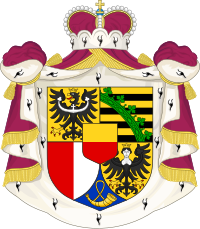Coat of arms of Liechtenstein
This article includes a list of references, related reading, or external links, but its sources remain unclear because it lacks inline citations. (November 2014) |
| Coat of arms of the Prince of Liechtenstein | |
|---|---|
 | |
| Versions | |
 The Lesser Arms of Liechtenstein | |
| Armiger | Hans Adam II, Prince of Liechtenstein |
| Shield | Quarterly: I Or, an eagle displayed Sable crowned and armed Or charged with a crescent treflée, issuing from the middle thereof a cross pattée Argent (Silesia); II barry of eight Or and Sable, a crown of rue bendways throughout Vert (Kuenring); III per pale Gules and Argent (Duchy of Troppau); IV Or, a harpy displayed Sable the human parts Argent crowned and armed Or (Cirksena); on a point entée Azure, a bugle-horn stringed Or (Duchy of Jägerndorf); en surtout, an inescutcheon per fess or and Gules (Princely House of Liechtenstein) |
| Other elements | Behind the shield a Princely mantle Purpure lined ermine ensigned with the Princely hat |
The Arms of Liechtenstein are the armorial bearings of the Prince of Liechtenstein, currently Hans-Adam II. As the sovereign emblem of the Prince, its use is restricted to the Prince and members of his House, though private individuals are permitted to use the arms if it is in the interest of the State. The arms are a history of the House, and show the many different regions and families with which Liechtenstein has been involved, either by conquest or by marriage.
The first quarter shows the arms of Silesia; the second the arms of the Kuenring family {de:Kuenringer}; the third the arms of the Duchy of Troppau; and the fourth the arms of the County of Rietberg. The base is occupied by the arms of the Duchy of Jägerndorf, while the arms of the Princely House itself are placed on a small shield in the centre. The whole shield is surrounded by a purple or red mantle with ermine lining and fringes and tassels of gold. At the top is placed the Princely hat.
The arms of the Princely House are sometimes used alone, and thus form the Lesser Arms of Liechtenstein. When shown alone, the arms are usually ensigned by the Princely hat.
